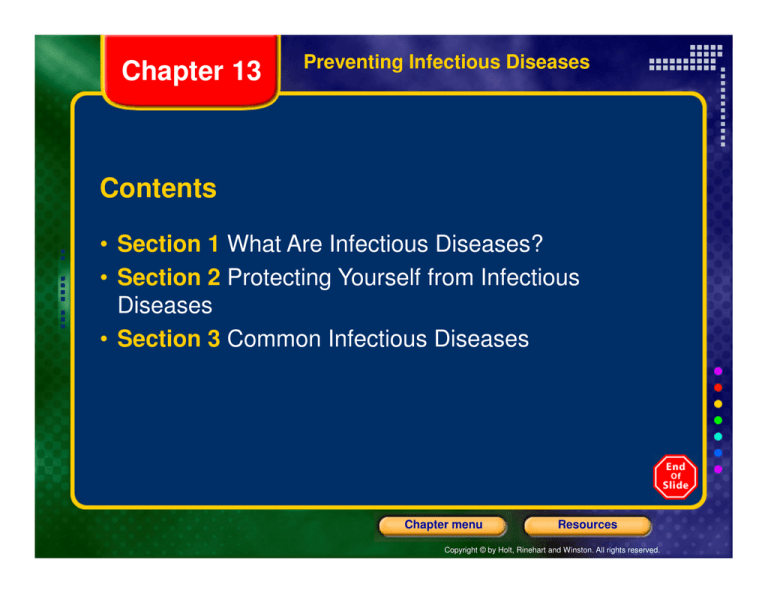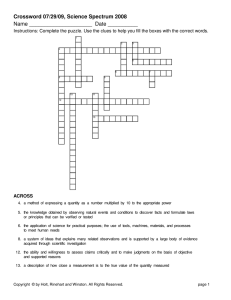
Chapter 13
Preventing Infectious Diseases
Contents
• Section 1 What Are Infectious Diseases?
• Section 2 Protecting Yourself from Infectious
Diseases
• Section 3 Common Infectious Diseases
Chapter menu
Resources
Copyright © by Holt, Rinehart and Winston. All rights reserved.
Chapter 13
Section 1 What Are Infectious
Diseases?
Bellringer
• List ten ways a person might come into contact with
infectious organisms.
Chapter menu
Resources
Copyright © by Holt, Rinehart and Winston. All rights reserved.
Chapter 13
Section 1 What Are Infectious
Diseases?
Objectives
• Identify five different agents that can cause
infectious diseases.
• List four ways that infectious diseases spread.
• Describe two different treatments for infectious
diseases.
• Name two ways you can help prevent the
development of antibiotic resistant bacteria.
Chapter menu
Resources
Copyright © by Holt, Rinehart and Winston. All rights reserved.
Chapter 13
Section 1 What Are Infectious
Diseases?
What Causes Infectious Diseases?
• Infectious diseases are diseases caused by agents
invading the body.
• Bacteria are single-celled organisms, some of which
cause disease. Other kinds of bacteria are harmless
or even helpful to the body. Tetanus, tuberculosis,
and sinus infections are bacterial diseases.
Chapter menu
Resources
Copyright © by Holt, Rinehart and Winston. All rights reserved.
Chapter 13
Section 1 What Are Infectious
Diseases?
What Causes Infectious Diseases?
• Viruses are tiny disease-causing particles made up
of genetic material and a protein coat. Viruses
survive and replicate inside living cells. Colds, the flu,
measles, chicken pox, and AIDS are viral diseases.
• Fungi are organisms that absorb and use the
nutrients of living or dead organisms. Some fungi
cause diseases, such as athlete’s foot and ringworm.
Chapter menu
Resources
Copyright © by Holt, Rinehart and Winston. All rights reserved.
Chapter 13
Section 1 What Are Infectious
Diseases?
What Causes Infectious Diseases?
• Protozoans are single-celled organisms that are
larger and more complex than bacteria. They
account for some of the leading causes of death
worldwide, including malaria.
• Parasites get their energy and nutrients by feeding
on other living things. Head lice, tapeworms, and
some roundworms are parasites.
Chapter menu
Resources
Copyright © by Holt, Rinehart and Winston. All rights reserved.
Chapter 13
Section 1 What Are Infectious
Diseases?
Chapter menu
Resources
Copyright © by Holt, Rinehart and Winston. All rights reserved.
Chapter 13
Section 1 What Are Infectious
Diseases?
How Are Infectious Diseases Treated?
• Antibiotics are medicines used to kill or slow the
growth of bacteria. Examples include penicillin,
tetracycline, and streptomycin.
• Antibiotic resistance is a condition in which
bacteria can no longer be killed by a particular
antibiotic.
• Improper use of antibiotics contributes to the growth
of antibiotic-resistant bacteria.
Chapter menu
Resources
Copyright © by Holt, Rinehart and Winston. All rights reserved.
Chapter 13
Section 1 What Are Infectious
Diseases?
Chapter menu
Resources
Copyright © by Holt, Rinehart and Winston. All rights reserved.
Chapter 13
Section 1 What Are Infectious
Diseases?
How Are Infectious Diseases Treated?
• Treating Viral Diseases Viral diseases are hard to
treat. Most antiviral medications focus on relieving
symptoms. Viruses are not affected by antibiotics.
• Treating Fungal Infections Some fungal infections
can be treated with over-the-counter antifungal
medications. Others require prescription medications.
Chapter menu
Resources
Copyright © by Holt, Rinehart and Winston. All rights reserved.
Chapter 13
Section 1 What Are Infectious
Diseases?
How Are Infectious Diseases Treated?
• Treating Protozoan Infections The best protection
is prevention through good hygiene and sanitation.
• Treating Parasites Head lice can be treated with
medicated shampoos.
Chapter menu
Resources
Copyright © by Holt, Rinehart and Winston. All rights reserved.
Chapter 13
Section 2 Protecting Yourself from
Infectious Diseases
Bellringer
• List ways that a pathogen might enter the body.
Chapter menu
Resources
Copyright © by Holt, Rinehart and Winston. All rights reserved.
Chapter 13
Section 2 Protecting Yourself from
Infectious Diseases
Objectives
•
•
•
•
•
Describe how the body fights infectious diseases.
Summarize five things a person can do to stay well.
Describe how immunity to a disease develops.
State three things you should do when you are sick.
List three things you can do to prevent the spread of
infectious diseases.
Chapter menu
Resources
Copyright © by Holt, Rinehart and Winston. All rights reserved.
Chapter 13
Section 2 Protecting Yourself from
Infectious Diseases
How Your Body Fights Disease
• Physical barriers to pathogens include:
• Skin
• Mucous membranes
• Chemicals
• Inflammation is a reaction to injury or infection
characterized by pain, redness, and swelling.
Chapter menu
Resources
Copyright © by Holt, Rinehart and Winston. All rights reserved.
Chapter 13
Section 2 Protecting Yourself from
Infectious Diseases
How Your Body Fights Disease
• The immune system is the body’s system for fighting
disease once it is in the body.
• White blood cells are cells in the blood that defend
the body against disease.
• Antibodies are proteins that mark pathogens to be
destroyed by white blood cells.
• The lymphatic system is a network of vessels that
carry lymph throughout the body, carrying viruses
and bacteria back to the lymph nodes.
Chapter menu
Resources
Copyright © by Holt, Rinehart and Winston. All rights reserved.
Chapter 13
Section 2 Protecting Yourself from
Infectious Diseases
What You Can Do to Stay Well
•
•
•
•
•
•
•
•
•
Protect yourself.
Eat a healthy, balanced diet.
Drink plenty of water.
Reduce your stress levels.
Exercise regularly.
Get regular medical checkups.
Avoid close contact with sick people.
Get enough sleep.
Stay up to date on all available vaccines.
Chapter menu
Resources
Copyright © by Holt, Rinehart and Winston. All rights reserved.
Chapter 13
Section 2 Protecting Yourself from
Infectious Diseases
What to Do When You Are Sick
•
•
•
•
Stay home and rest.
Drink plenty of fluids.
Throw away tissues you use right away.
Follow all the directions your doctor gives.
Chapter menu
Resources
Copyright © by Holt, Rinehart and Winston. All rights reserved.
Chapter 13
Section 2 Protecting Yourself from
Infectious Diseases
How to Prevent the Spread of Disease
• Get vaccinated.
• Keep clean by washing with soap frequently.
• Don’t share food, drinks, or personal items such as
toothbrushes.
• Cover your mouth when you sneeze or cough.
Chapter menu
Resources
Copyright © by Holt, Rinehart and Winston. All rights reserved.
Chapter 13
Section 2 Protecting Yourself from
Infectious Diseases
How to Prevent the Spread of Disease
• When you are outdoors:
•
•
•
•
wear long-sleeved shirts and pants in long grass
use insect repellant when necessary
avoid contact with animals that behave strangely
avoid drinking and swimming in remote waters
Chapter menu
Resources
Copyright © by Holt, Rinehart and Winston. All rights reserved.
Chapter 13
Section 3 Common Infectious
Diseases
Bellringer
• List as many infectious diseases as you can. What
type of pathogen do you think causes each of the
diseases in your list?
Chapter menu
Resources
Copyright © by Holt, Rinehart and Winston. All rights reserved.
Chapter 13
Section 3 Common Infectious
Diseases
Objectives
• State why diseases affect everybody.
• Identify two bacterial diseases, and describe their
symptoms and ways that they are spread.
• Identify two viral diseases, and describe their
symptoms and ways that they are spread.
• List examples of fungal, protozoan, and parasitic
infections, and describe their symptoms.
• Name two organizations in your community that help
treat and prevent the spread of infectious diseases.
Chapter menu
Resources
Copyright © by Holt, Rinehart and Winston. All rights reserved.
Chapter 13
Section 3 Common Infectious
Diseases
Diseases Affect Everybody
• No matter how healthy we are, we all become ill from
diseases sometimes.
• There are so many pathogens in so many places it is
impossible to avoid them.
• The best defense against pathogens is avoiding
behaviors that increase our chances of infection.
Chapter menu
Resources
Copyright © by Holt, Rinehart and Winston. All rights reserved.
Chapter 13
Section 3 Common Infectious
Diseases
Chapter menu
Resources
Copyright © by Holt, Rinehart and Winston. All rights reserved.
Chapter 13
Section 3 Common Infectious
Diseases
Common Bacterial Diseases
• Tetanus causes severe muscle spasms. It can enter
the body through cuts or wounds. Vaccinations are
the best form of prevention.
• Strep throat causes a sore throat and spots on the
tonsils. It is spread by contact with mucus. The best
prevention is avoiding contact with infected people.
Chapter menu
Resources
Copyright © by Holt, Rinehart and Winston. All rights reserved.
Chapter 13
Section 3 Common Infectious
Diseases
Common Bacterial Diseases
• Meningitis causes inflammation of membranes
around the brain and spinal cord. It is spread by
contact with mucus or saliva. There are some
vaccines for meningitis.
• Sinus infections cause headaches, mucus, and
pressure in the head. They are spread by contact
with mucus. Prevention includes avoiding infected
people and avoiding irritants and allergens in the air.
Chapter menu
Resources
Copyright © by Holt, Rinehart and Winston. All rights reserved.
Chapter 13
Section 3 Common Infectious
Diseases
Common Bacterial Diseases
• Salmonellosis causes headaches, stomach cramps,
diarrhea, and nausea. It is spread by eating food
from an infected animal or food contaminated by an
infected person. Prevention involves proper
refrigeration, cooking, and handling of food.
Chapter menu
Resources
Copyright © by Holt, Rinehart and Winston. All rights reserved.
Chapter 13
Section 3 Common Infectious
Diseases
Chapter menu
Resources
Copyright © by Holt, Rinehart and Winston. All rights reserved.
Chapter 13
Section 3 Common Infectious
Diseases
Chapter menu
Resources
Copyright © by Holt, Rinehart and Winston. All rights reserved.
Chapter 13
Section 3 Common Infectious
Diseases
Other Common Diseases
• Fungal infections include Athlete’s foot, jock itch,
and ringworm. These often occur when the fungus
contacts warm, moist skin. Prevention involves good
personal hygiene and keeping clothes dry.
• Malaria is the most widespread and serious
protozoan disease. It is spread from person to
person via mosquitoes. Malaria can be prevented
and treated with antimalarial medicines.
Chapter menu
Resources
Copyright © by Holt, Rinehart and Winston. All rights reserved.
Chapter 13
Section 3 Common Infectious
Diseases
Other Common Infections
• Parasitic infections include hookworms and
tapeworms inside the body, and lice, leeches, ticks,
and fleas on the body.
• A person can contract parasites by eating infected
food, drinking infected water, contacting infected soil,
and by being bitten by infected insects.
Chapter menu
Resources
Copyright © by Holt, Rinehart and Winston. All rights reserved.
Chapter 13
Section 3 Common Infectious
Diseases
Working Toward a Healthy Future
• International air travel has made it easier for
diseases to spread from country to country.
• The National Institute of Health (NIH) and Centers for
Disease Control (CDC) track the spread of diseases
and watch for new diseases entering the country.
• Public health organizations throughout the world fight
diseases through vaccinations and treatments.
Chapter menu
Resources
Copyright © by Holt, Rinehart and Winston. All rights reserved.




